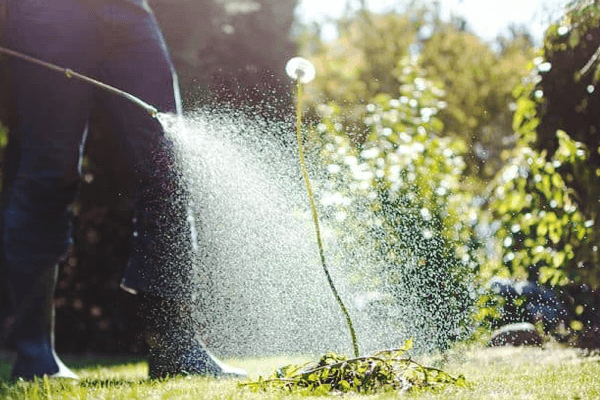Roundup is the widely used Glyphosate-based chemical herbicide that kills weeds and grass to keep your lawn and garden clean. This specialized weed killer is used on genetically modified seeds that are not affected by this chemical and are tolerant to Glyphosate.
If you are a Roundup user, these basic questions must have come to your mind. Which weather is best for applying Roundup? Does Roundup need sunlight to work?
No. It is not mandatory to apply Roundup in bright sunlight. Sunlight has no explicit role in the functions of Roundup. But it is recommended to use Roundup on a sunny rainless day. Otherwise, the chemical won’t get actively absorbed by the plant systems.

Contents
What Is Roundup?
Suppose you have a lawn or a garden that you cherish a lot. But the unnecessary grass and weeds are affecting both the growth and beauty of your garden. Won’t you hunt down the best product to stop that? Roundup is here to help you!
To protect your plants, Monsanto has come up with a unique product called Roundup. Though Bayer later acquired Monsanto in 2018. This herbicide flows all the way down to the plant system and stops its growth.
Weed control in your yard and flowerbed can feel like a full-time job at times, but herbicides like Roundup can make it easier and faster.
Roundup, which was once created for large-scale farming operations, is now available in home and garden variants. It has become a popular domestic weed killer all over the world.
How Does Roundup Work?
The main ingredient of Roundup is Glyphosate salt content. Surfactants, which vary in origin and concentration, are also included in commercial Roundup formulations in addition to the glyphosate salt.
As a result, the herbicide’s primary and secondary effects are not solely due to the principal active component.
Roundup starts working as soon as it is sprayed on a plant. The main ingredient, glyphosate, is swiftly absorbed by the plant leaves. Plant wilting may occur within a few hours, although Roundup can take one to two weeks to reach all plant systems.
Why Use Roundup in Sunlight?
The chemical formula prevents plants from producing proteins required for cell division. It attacks the plant’s leaf, root, and stem systems after penetrating the leaves. This takes time, but because of this systemic attack on weeds, Roundup is so efficient at permanently eliminating plants.
While the plants are actively growing and transpiring moisture, glyphosate should be administered. This implies you should apply glyphosate first thing in the morning so it can work all day.
So, apply first thing in the morning on a sunny, warm day with no chance of rain.
How To Use Roundup in Sunlight?
It’s critical to use Roundup Products correctly for the best results. Of course, all of the instructions are printed on the back of the bottle, but having a few hints always helps.
So, in that spirit, here are our recommendations for mastering Roundup products.
Step 01 – Apply It As Early As Possible
It is recommended to apply Roundup while the weeds and grass are at the early stage. So that Glyphosate can work effectively and efficiently on them.
Step 02 – Select The Perfect Condition
Plant leaves ingest Roundup during photosynthesis as they transfer moisture. As a result, choose a day that is over 60 degrees Fahrenheit and is wind- and rain-free.
However, avoid using Glyphosate on sweltering and extremely windy days, as this can reduce its effectiveness.
Step 03 – Apply In The Morning Or Daytime
Spraying Roundup late at night will be unsuccessful because plants do not undergo photosynthesis at night.
Roundup can only be consumed by plants in liquid form. If you apply roundup at night, it will dry off and not be absorbed.
Step 04 – Spray Equally And Correctly
Roundup should be sprayed evenly on all plants. For continuous spraying, keep your finger on the trigger and position the nozzle away from your body.
Step 05 – Wait For Results
It takes the plants at least 2-3 days to start twisting. But to kill all the weeds and grass properly, you have to wait for 7-14 days. So wait patiently for perfect results.
How To Make Roundup Work Better in Sunlight?
You can do a few things to help Roundup perform better on weeds that are difficult to control. Here are some easy steps to follow:
Step 01 – Apply In Sunny Weather
As we have told before, to get the best out of Roundup, you should apply it on a dry, rainless, windy day when the temperature is over 60° F.
When the leaves are dry and ready to absorb moisture, Roundup works best. Choose a warm, sunny day that isn’t too hot or too cold, but not one when the plants are already stressed by drought or too much water.
Step 02 – Keep The Water Amount Low
Water volume does not always imply better control. If you’re spraying little weeds, you’ll want to use less water, which means each spray droplet will be more condensed.
Maintain a water level of 5 to 10 gallons per acre while spraying Roundup at first.
Step 03 – Use The Correct Amount
Using too much Roundup doesn’t increase its effectiveness. So using the correct amount is the answer.
Always measure the amount of Roundup you need according to the amount of land.
Step 04 – Use Flat Fan Nozzles
Spray droplets are smaller with flat fan nozzles. This translates to better spray coverage and, as a result, slightly better Roundup weed control.
Step 05 – Mix Non-ionic Surfactant
Applying a non-ionic surfactant improves Roundup’s spreading and adhesion to weed leaves, and it somewhat enhances control.
Frequently Asked Questions (FAQs)
Can I use Roundup on any kind of plant?
Glyphosate is indifferent to types of plants. It works on every plant the same and stops their growth. So it can only be used on genetically modified or engineered seeds that are tolerant to Glyphosate.
Is Glyphosate harmful to human health?
Of course, too much Glyphosate is harmful to health. But EPA has stated that Glyphosate has low toxicity to the human body. So to become dangerous, you’d have to be exposed to a high amount of glyphosate.
How many days do I need to wait before planting new seeds?
It takes Roundup at most 7-14 days to kill all the weeds and grass completely. So wait for at least 7-14 days. If you’re growing lawn grasses, herbs, fruits, or vegetables, wait three days after applying these Roundup products.
Final Words
Roundup is the ultimate solution for weeds and grass cleaning and the most widely used herbicide too. Clear out your confusion regarding the need for sunlight to make Roundup work. Learn that sunlight has no direct connection to the functions of Roundup.
However, you have to choose a dry, windy, and rain-free day in which your plant can absorb moisture. And obviously, you have to choose the morning time which is recommended. Now you can use Roundup in your lawn and garden without any worries!
